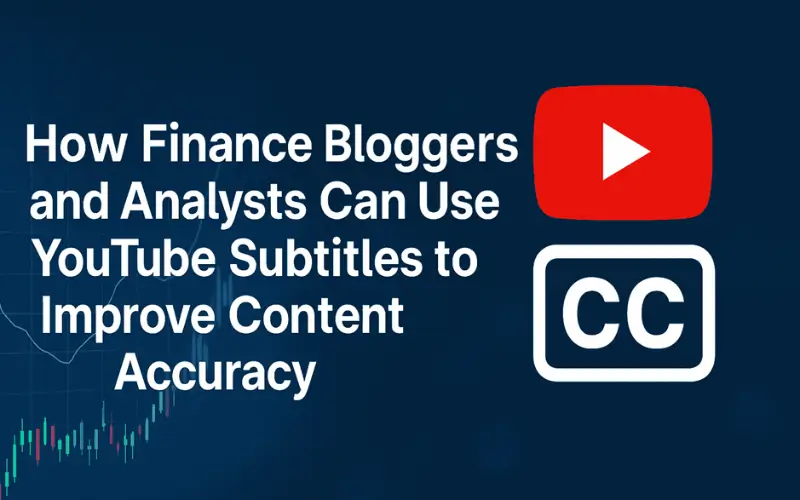In finance, the smallest misquote can turn accuracy into error. A misplaced decimal. A misunderstood hedge. A name lost in a fast-spoken earnings call. These things matter, and that’s exactly why subtitles are no longer just accessibility tools. They’re content accuracy tools.
When I started reviewing macro briefings regularly, I didn’t pay much attention to subtitle accuracy. I assumed I was catching most of the language live. But the more I double-checked, the more I realized I was missing crucial phrasing. I wasn’t just hearing the message. I was filtering it. Subtitles gave me the words, not my interpretation of them.
The Analyst’s Tactical Advantage for Decoding Expert Commentary
Finance creators work in a sea of spoken nuances. From policy speeches to CEO interviews, the most valuable content arrives in video form. But not everyone speaks slowly. Not every accent is easy to process. Some ideas land quietly, even when they’re the loudest thing said.
Subtitles act like a second set of ears. They reduce ambiguity, clarify terminology, and give you a clean slate to analyze. This matters when you’re breaking down statements from Federal Reserve officials or deciphering a fast-moving Q&A with a hedge fund manager.
There have been times when I’ve written entire paragraphs for an analysis piece, only to realize later that I had misunderstood one phrase in the video. The subtitle transcript didn’t lie. It made me feel better.
Editing Your Own Subtitles Builds Credibility
If you publish video content yourself, uploading your own subtitles is not optional anymore. It’s mandatory for clarity. Especially when you’re diving into projections, historical comparisons, or referencing real-time market data.
YouTube auto-captions have improved, but they still mislabel financial terms. Try saying “monetary tapering” three times fast and watch what auto-subtitles do with it. That’s not a detail you can afford to leave broken. Manually edited subtitle files keep your voice accurate and professional. They also make your video content searchable, which can help surface your videos more reliably in relevant searches.
In my case, one video about bond yield spreads started ranking higher in search two weeks after I uploaded revised subtitles. My CTR didn’t jump, but my retention numbers quietly improved. Viewers stayed because the subtitles helped them follow complex topics.
Using Subtitles from Other Videos to Build Smarter Commentary
Sometimes, I’m not the one publishing. I’m analyzing. That means I’m pulling insights from other creators, speakers, or institutions. And when those videos are dense or loaded with niche-specific phrases, subtitles help me avoid assumptions.
Instead of replaying a 45-minute conference twice, I download the subtitle file and scan the relevant portion. This saves time and reduces error. I’ve done this for FOMC pressers and investment committee roundtables — anything where phrasing matters more than tone.
To make this process smooth, I use a YouTube video downloader with subtitles because it lets me grab the transcript and timing data without stripping quality. That one tool drastically improves efficiency. Based on my workflow, it trims prep time by close to 40%, especially when dealing with multi-speaker videos that require close inspection.
Having that transcript in hand means I can quote directly, time-stamp references, and avoid rewording that might skew intent.
What to Do After You Have the Subtitles
Downloading is only the beginning. Once the subtitle file is on your desktop, the real work begins.
First, identify the phrases or data points that matter. Look for names, percentages, time frames, and key conclusions. These aren’t just highlights. They’re anchors for your own content. Use them to frame summaries, generate pull quotes, or build quick factsheets.
Second, align those phrases with timestamps. That way, if you’re embedding the original video or linking it, readers can jump straight to the source. It’s a simple move that instantly builds transparency.
Lastly, compare the subtitles to your draft. Are you paraphrasing anything that changes the meaning? If yes, swap it out for a direct quote. Readers trust precision more than tone.
International Markets Need Even Sharper Tools
The finance world doesn’t speak in just one language. If you’re analyzing content from global speakers, subtitles can bridge that gap in real time.
Even native English speakers can struggle with cross-border phrasing. What a European economist means by “policy neutrality” may differ slightly from how a US-based analyst defines it. Subtitles reveal subtle differences. They also help when translating your own content — feeding subtitle files into translation tools produces more accurate results than voice-to-text alone.
I’ve used this trick when publishing summaries from APAC-based investor briefings. The speakers were fluent, but the pace and pronunciation demanded help. Subtitles saved me from over-editing and misframing the original tone.
Don’t Rely on Subtitles Alone; Always Cross-Check
Even with the best tools, mistakes slip through. Subtitles may still auto-correct terminology incorrectly or truncate longer thoughts. Relying on them without reviewing the actual video is like quoting a book by skimming the back cover.
Always double-check figures. Match subtitles to visuals when numbers are displayed. And when you’re quoting controversial statements or nuanced answers, make sure you’ve got the full context.
Accuracy doesn’t just protect your reputation. It protects your readers from making decisions based on half-right data.
FAQs
What’s the safest way to pull subtitles from YouTube videos without losing formatting?
Use a subtitle downloader that supports .srt or .vtt files. These keep timestamps intact, making it easier to quote and cite specific segments.
Can subtitles help increase the SEO performance of financial video content?
Yes. YouTube indexes subtitle text, and Google uses it to improve search result matching. Subtitles also increase watch time by improving accessibility.
Is it legal to use subtitle text from public videos in my own analysis?
In most cases, yes. If your usage falls under commentary, critique, or education, and you’re not re-uploading or redistributing the video itself, it qualifies as fair use. Still, crediting the source is best practice.




